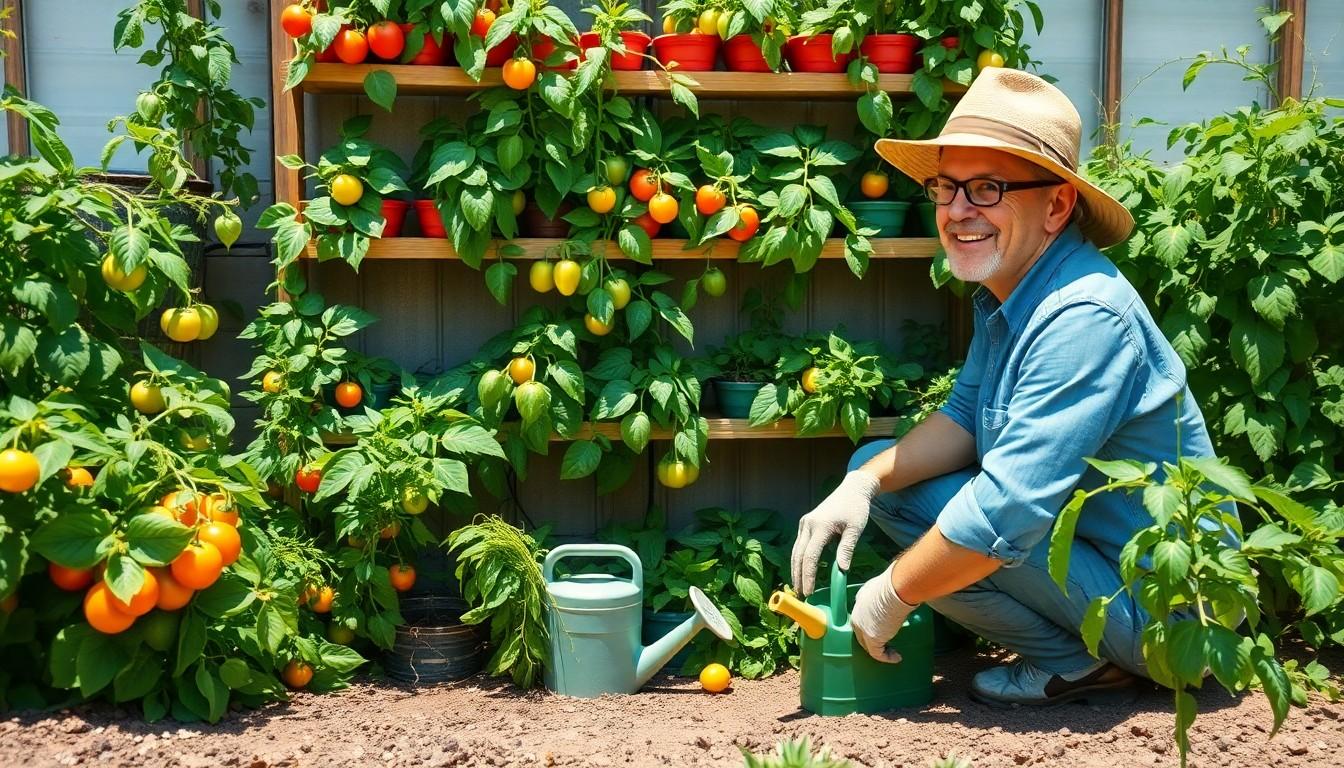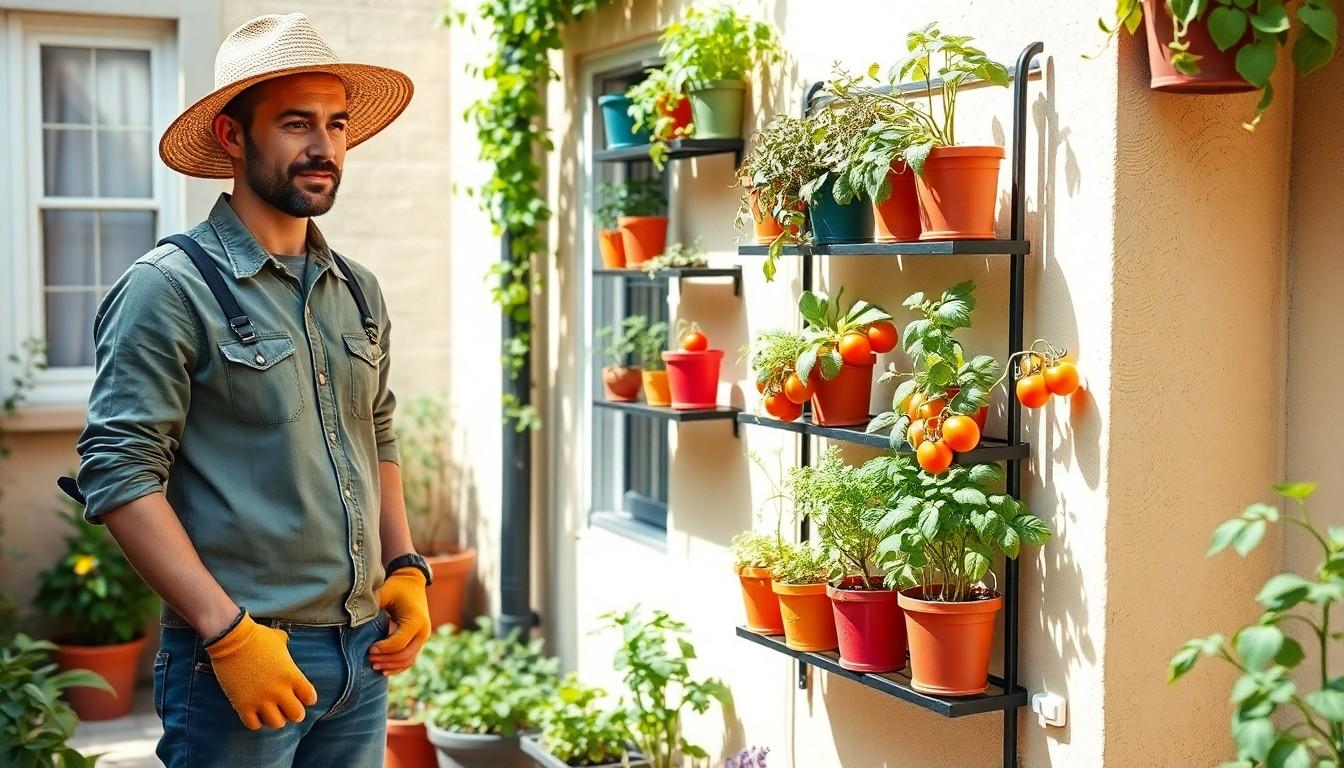Imagine stepping into your backyard and being greeted by a lush, green wall of fresh veggies. Sounds like a dream, right? With a DIY vertical vegetable garden, that dream can become a reality. Not only does this gardening method save space, but it also transforms even the tiniest of patios into a vibrant oasis. Who knew that growing your own food could be as easy as stacking some crates and getting your hands a little dirty?
Benefits Of A DIY Vertical Vegetable Garden
Creating a DIY vertical vegetable garden offers numerous advantages. Home gardeners enjoy the freedom to cultivate fresh produce efficiently within limited spaces.
Space Efficiency
Maximizing limited space ranks as a primary benefit of vertical gardens. Such gardens utilize vertical structures, making it possible to grow vegetables in compact areas. Small yards or balconies accommodate multiple plants without occupying much ground. Utilizing shelving systems or wall-mounted planters allows for greater plant density. Gardeners transform unused vertical space into thriving gardens, making gardening accessible for urban dwellers or those with restricted outdoor areas.
Increased Yield
Boosting yield emerges as another vital benefit of vertical gardening. Plants grown vertically often enjoy improved sunlight exposure compared to traditional gardens. Enhanced air circulation helps reduce disease risk, promoting healthier growth. Many vegetables thrive in vertical settings, including tomatoes, peppers, and cucumbers. Gardeners frequently achieve up to 30 percent more yield from vertical setups than conventional gardens. More space and improved conditions lead to productive harvests, ideal for home cooks seeking fresh ingredients.
Choosing The Right Location

Selecting the right location for a DIY vertical vegetable garden ensures successful growth. Factors like sunlight and accessibility play crucial roles in maximizing yield.
Sunlight Requirements
Light exposure determines plant health. Most vegetables need six to eight hours of direct sunlight daily. Position the garden in a south-facing area for optimal exposure. Consider monitoring shadows from nearby structures or trees throughout the day. Adequate sunlight boosts photosynthesis, leading to stronger plants. Choose varieties like tomatoes and peppers that thrive in bright light. If limited sunlight is unavoidable, opt for shade-tolerant vegetables, such as lettuce or spinach, that can still flourish in partial shade.
Accessibility Considerations
Convenience shapes gardening habits. Position the vertical garden close to a water source for easy maintenance. Height matters; elevated structures facilitate effortless harvesting and weeding. Create pathways for easy access to all plants, preventing disruption of growth. Consider using tiered shelves that allow for comfortable reach. Think about incorporating a sturdy framework that supports the weight of fully grown plants. Prioritizing accessibility ensures a rewarding gardening experience, promoting regular care and maximizing edible harvests.
Essential Materials And Tools
Creating a DIY vertical vegetable garden involves gathering specific materials and tools for successful construction and planting.
Required Gardening Supplies
Start with high-quality potting soil to provide essential nutrients for plants. Choose a variety of seeds or starter plants suitable for vertical gardening, like tomatoes, cucumbers, or herbs. Select containers such as pots, planters, or repurposed materials that suit the chosen vertical structure. Incorporate a good fertilizer to encourage healthy growth. Mulch can help retain moisture and regulate temperature in the containers. Lastly, use a watering can or a drip irrigation system to ensure consistent moisture for plants.
Tools For Construction
Collect basic tools to facilitate the building process. A drill serves well for creating holes in wood or other materials. Use screws or brackets to secure the vertical structure. Measuring tape helps ensure proper dimensions for the garden frame. Gardening gloves protect hands while handling soil and plants. A level guarantees stability for vertical arrangements. Opt for a saw to cut wooden boards according to specific measurements. Include a trowel for potting soil and transplanting plants. Each tool plays a significant role in assembling a functional and attractive garden.
Design Ideas For Your Vertical Garden
Creating a vertical garden offers exciting opportunities for customization and creativity. Various designs cater to different tastes while optimizing space for vegetable growth.
Wall-mounted Planters
Wall-mounted planters provide a stylish solution for limited spaces. They can accommodate a variety of vegetables like herbs, cherry tomatoes, and strawberries. Installation is straightforward, requiring brackets or hooks to secure planters directly onto walls. Consider staggered arrangements for visual interest. Optimize sunlight exposure by positioning planters to receive direct light. Regular watering is essential, as vertical installations may dry out faster. Drainage holes in containers prevent water accumulation, safeguarding plant health. This design not only enhances aesthetics but also simplifies access for harvesting.
Repurposed Pallets
Repurposed pallets create an eco-friendly option for vertical gardening. Pallets can be converted into planters by filling each section with soil and plants. This method utilizes both horizontal and vertical spaces effectively. Choose shallow-rooted vegetables like lettuce or herbs for the best results. Stabilizing pallets against walls or fences ensures their durability. Adding a protective liner inside helps retain soil and moisture while preventing damage. This approach emphasizes sustainability, transforming what would be waste into a productive garden feature. With creativity, pallets add character and functionality to any outdoor area.
Plant Selection Tips
Selecting the right plants enhances the success of a DIY vertical vegetable garden. The choice influences growth, maintenance, and yield.
Best Vegetables For Vertical Growth
Tomatoes, peas, and cucumbers thrive in vertical gardens. These crops benefit from climbing structures, maximizing space and sunlight exposure. Herbs like basil and parsley also work well, adding flavor and aroma. Leafy greens, such as spinach and lettuce, can flourish in controlled environments. For best results, choose compact or bush varieties designed for vertical growth. Growing up rather than out conserves space, allowing for higher yields in smaller areas.
Companion Planting Strategies
Companion planting promotes healthy growth and pest control. Pairing tomatoes with basil enhances flavor and wards off certain pests. Similarly, planting cucumbers with radishes can deter cucumber beetles, benefiting both crops. Utilizing marigolds alongside vegetables can repel unwanted insects, enriching the garden’s ecosystem. Combining compatible plants creates a thriving environment, also maximizing the use of vertical space. This strategy ensures a diverse garden with improved productivity, leading to successful edible harvests.
Maintenance And Care
Maintaining a DIY vertical vegetable garden requires consistent attention. Routine care ensures plants thrive and produce healthy yields.
Watering Techniques
Watering holds significant importance for plant health. Plants in vertical gardens often dry out faster due to increased exposure to sunlight and wind. Using a watering can or a drip irrigation system allows for precise moisture control. Watering in the morning helps minimize evaporation and encourages deep root growth. Regular checks on soil moisture levels help in understanding each plant’s needs. Incorporating mulch retains moisture and suppresses weeds, promoting overall garden health.
Pest Control Methods
Effective pest control safeguards plants against harmful insects. Regular monitoring of plants allows for early detection of infestations. Handpicking pests can eliminate them without chemicals. Introducing beneficial insects helps maintain a balanced ecosystem within the garden. Neem oil serves as a natural pesticide, deterring various pests while being gentle on plants. Companion planting strategies enhance pest resistance by confusing or repelling unwanted insects. Implementing these methods protects the garden and promotes healthy vegetable growth.
Conclusion
A DIY vertical vegetable garden offers an innovative way to grow fresh produce in limited spaces. By maximizing vertical structures and utilizing creative design ideas, anyone can enjoy the benefits of home gardening. With the right materials and careful planning, it’s possible to cultivate a thriving garden that not only enhances urban living but also promotes sustainability.
Regular maintenance and thoughtful plant selection ensure a bountiful harvest. Whether it’s herbs or climbing vegetables, vertical gardening can transform any small area into a vibrant source of fresh ingredients. Embracing this gardening method can lead to a fulfilling and productive experience, making it an excellent choice for both novice and experienced gardeners alike.

